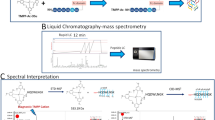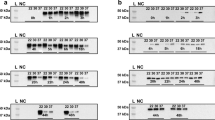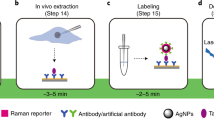Abstract
Nonsense or frameshift mutations, which result in a truncated gene product, are prevalent in a variety of disease-related genes1, including APC (implicated in colorectal cancer)2,3,4,5,6, BRCA1 and BRCA2 (breast and ovarian cancer)7,8,9, PKD1 (polycystic kidney disease)10, NF1 and NF2 (neurofibromatosis)11,12, and DMD (Duchenne muscular dystrophy)13. Such chain-truncating mutations can be detected using the protein truncation test (PTT). This test is based on cell-free transcription and translation of either PCR-amplified portions of the target gene or RT-PCR amplified target mRNA, followed by analysis of the product(s) for shortened polypeptide fragments. However, conventional PTT is not easily adapted to high-throughput applications because it involves SDS-PAGE followed by autoradiography or western blotting. It is also subject to human error, as it relies on visual inspection to detect the mobility of shifted bands. To overcome these limitations, we have developed a high-throughput solid-phase protein truncation test (HTS-PTT). HTS-PTT uses a combination of misaminoacylated tRNAs14,15, which incorporate affinity tags for surface capture of the cell-free expressed protein fragments, and specially designed PCR primers, which introduce N- and C-terminal markers for measuring the relative level of shortened polypeptides produced by the chain-truncation mutation. After cell-free translation of the protein fragments, capture and detection are accomplished in a single well using a standard 96-well microtiter plate enzyme-linked immunosorbent assay (ELISA) format and chemiluminescence readout. We demonstrate the use of the technique to detect chain-truncation mutations in the APC gene using DNA or RNA from cancer cell lines as well as DNA of individuals diagnosed with familial adenomatous polyposis (FAP). HTS-PTT can also provide a high-throughput method for noninvasive colorectal cancer screening when used in conjunction with methods of enriching and amplifying low-abundance mutant DNA4.
This is a preview of subscription content, access via your institution
Access options
Subscribe to this journal
Receive 12 print issues and online access
$209.00 per year
only $17.42 per issue
Buy this article
- Purchase on Springer Link
- Instant access to full article PDF
Prices may be subject to local taxes which are calculated during checkout



Similar content being viewed by others
References
Den Dunnen, J.T. & Van Ommen, G.J. The protein truncation test: a review. Hum. Mutat. 14, 95–102 (1999).
Powell, S.M. et al. Molecular diagnosis of familial adenomatous polyposis. N. Engl. J. Med. 329, 1982–1987 (1993).
van der Luijt, R. et al. Rapid detection of translation-terminating mutations at the adenomatous polyposis coli (APC) gene by direct protein truncation test. Genomics 20, 1–4 (1994).
Traverso, G. et al. Detection of APC mutations in fecal DNA from patients with colorectal tumors. N. Engl. J. Med. 346, 311–320 (2002).
Kinzler, K.W. et al. Identification of a gene located at chromosome 5q21 that is mutated in colorectal cancers. Science 251, 1366–1370 (1991).
Groden, J. et al. Identification and characterization of the familial adenomatous polyposis coli gene. Cell 66, 589–600 (1991).
Hogervorst, F.B. et al. Rapid detection of BRCA1 mutations by the protein truncation test. Nat. Genet. 10, 208–212 (1995).
Garvin, A.M. A complete protein truncation test for BRCA1 and BRCA2. Eur. J. Hum. Genet. 6, 226–234 (1998).
Futreal, P.A. et al. BRCA1 mutations in primary breast and ovarian carcinomas. Science 266, 120–122 (1994).
Peral, B. et al. Identification of mutations in the duplicated region of the polycystic kidney disease 1 gene (PKD1) by a novel approach. Am. J. Hum. Genet. 60, 1399–1410 (1997).
Heim, R.A. et al. Distribution of 13 truncating mutations in the neurofibromatosis 1 gene. Hum. Mol. Genet. 4, 975–981 (1995).
Parry, D.M. et al. Germ-line mutations in the neurofibromatosis 2 gene: correlations with disease severity and retinal abnormalities. Am. J. Hum. Genet. 59, 529–539 (1996).
Roest, P.A. et al. Protein truncation test (PTT) to rapidly screen the DMD gene for translation terminating mutations. Neuromuscul. Disord. 3, 391–394 (1993).
Rothschild, K.J. & Gite, S. tRNA-mediated protein engineering. Curr. Opin. Biotechnol. 10, 64–70 (1999).
Gite, S., Mamaev, S., Olejnik, J. & Rothschild, K. Ultrasensitive fluorescence-based detection of nascent proteins in gels. Anal. Biochem. 279, 218–225 (2000).
Roest, P.A., Roberts, R.G., Sugino, S., van Ommen, G.J. & den Dunnen, J.T. Protein truncation test (PTT) for rapid detection of translation-terminating mutations. Hum. Mol. Genet. 2, 1719–1721 (1993).
Rowan, A.J. & Bodmer, W.F. Introduction of a myc reporter tag to improve the quality of mutation detection using the protein truncation test. Hum. Mutat. 9, 172–176 (1997).
de Koning Gans, P.A., Ginjaar, I., Bakker, E., Yates, J.R. & den Dunnen, J.T. A protein truncation test for Emery-Dreifuss muscular dystrophy (EMD): detection of N-terminal truncating mutations. Neuromuscul. Disord. 9, 247–250 (1999).
Kahmann, S. et al. A non-radioactive protein truncation test for the sensitive detection of all stop and frameshift mutations. Hum. Mutat. 19, 165–172 (2002).
Deuter, R. & Muller, O. Detection of APC mutations in stool DNA of patients with colorectal cancer by HD-PCR. Hum. Mutat. 11, 84–89 (1998).
Doolittle, B.R., Emanuel, J., Tuttle, C. & Costa, J. Detection of the mutated K-Ras biomarker in colorectal carcinoma. Exp. Mol. Pathol. 70, 289–301 (2001).
Frischmeyer, P.A. & Dietz, H.C. Nonsense-mediated mRNA decay in health and disease. Hum. Mol. Genet. 8, 1893–1900 (1999).
Laurent-Puig, P., Beroud, C. & Soussi, T. APC gene: database of germline and somatic mutations in human tumors and cell lines. Nucleic Acids Res. 26, 269–270 (1998).
Mamaev, S., Olejnik, J., Olejnik, E. & Rothschild, K.J. N-terminal labeling of proteins using amber suppressor initiator tRNA. Protein Sci. 11 (suppl. 1), 171 (2002).
Acknowledgements
We wish to thank S. Mamaev, U. RajBhandary, and J. Hecht for helpful discussions. This work was funded by a Phase II SBIR grant (CA83396) from the National Cancer Institute to AmberGen, Inc.
Author information
Authors and Affiliations
Corresponding author
Ethics declarations
Competing interests
S.G., M.L., R.C., J.O., and K.J.R. are employees of AmberGen, Inc.
Rights and permissions
About this article
Cite this article
Gite, S., Lim, M., Carlson, R. et al. A high-throughput nonisotopic protein truncation test. Nat Biotechnol 21, 194–197 (2003). https://doi.org/10.1038/nbt779
Received:
Accepted:
Published:
Issue Date:
DOI: https://doi.org/10.1038/nbt779



